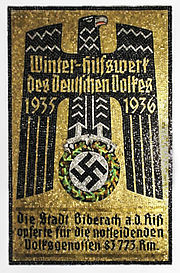
Back منظمة الإغاثة الشتوية للشعب الألماني Arabic Winterhilfswerk des Deutschen Volkes German Winterhilfswerk Esperanto Winterhilfswerk Spanish Talviapu Finnish Winterhilfswerk French 冬季援助活動 Japanese Winterhilfswerk des Deutschen Volkes NB Niemiecka Pomoc Zimowa Polish Зимняя помощь Russian
This article needs additional citations for verification. (April 2014) |
Winterhilfswerk des Deutschen Volkes | |
| Abbreviation | WHW |
|---|---|
| Formation | 1933 |
| Founded at | Berlin |
| Dissolved | May 9, 1945 |
| Type | Welfare organization |
| Location | |
Region served | Germany |
| Services | Food, clothing and fuel distribution |
| Leader | Erich Hilgenfeldt |
Parent organization | National Socialist People's Welfare |
| Funding | Public contributions |

The Winterhilfswerk des Deutschen Volkes (English: Winter Relief of the German People), commonly known by its abbreviated form Winterhilfswerk (WHW), was an annual donation drive by the National Socialist People's Welfare (German: Nationalsozialistische Volkswohlfahrt) to help finance charitable work. Initially an emergency measure to support people during the Great Depression, it went on to become a major source of funding for the activities of the NSV and a major component of Germany's welfare state. Donations to the WHW, which were voluntary in name but de facto required of German citizens, supplanted tax-funded welfare institutions and freed up money for rearmament.[1][2] Furthermore, it had the propagandistic role of publicly staging the solidarity of the Volksgemeinschaft.[3]
- ^ Kramer 2017, p. 144.
- ^ Evans 2005, p. 491.
- ^ Scriba 2015.